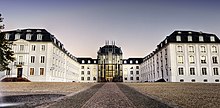Picture Source: http://de.wikipedia.org/wiki/Alte_Br%C3%BCcke_(Heidelberg)
Another major tourist attraction is the Saarbrucken Castle. The castle dates back to somewhere around the year 999. The castle was then made a part of a palace complex in the 18th century. In the 19th century, the complex was burned down. It was renovated in the 20th century and currently serves as a major government headquarters for Germany.

Picture Source: http://en.wikipedia.org/wiki/Saarbr%C3%BCcken_Castle
Bremen's Town Hall is a major tourist attraction. It was built between 1405 and 1410. It is the only European Town Hall, built in the middle ages, that hasn't been altered or destroyed.

Picture Source: http://en.wikipedia.org/wiki/Bremen_Town_Hall
Another major tourist attraction is the statue of Roland that stands in the town square. The statue is a symbol of freedom and trading rights. The statue was built over 600 years ago and it is believed that as long as the statue stands watch over the city, Bremen will remain free and independent.

Picture Source: http://en.wikipedia.org/wiki/Bremen_Roland
Lower Saxony is home to the Rammelsberg, a mountain that stands 635 meters high. The Rammeslberg is the location of a mine that was in operation for over 1,000 years before it closed down in 1988. The mine became a Unesco World Heritage site in 1992.

Picture Source: http://en.wikipedia.org/wiki/Rammelsberg
The Saint Michaels church is another attraction for Lower Saxony. It was constructed between 1001 and 1031. The church was named after Michael, the Christian Archangel of protection. The church became a Unesco World Heritage site in 1985.

http://en.wikipedia.org/wiki/St._Michael's_Church,_Hildesheim
